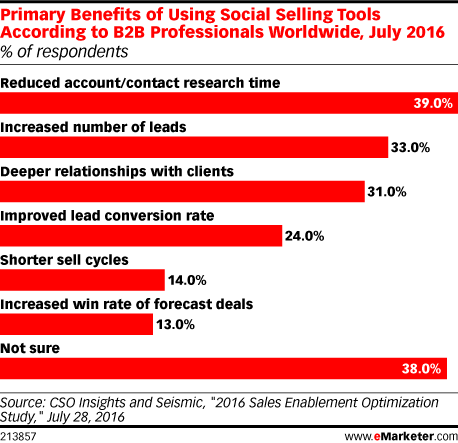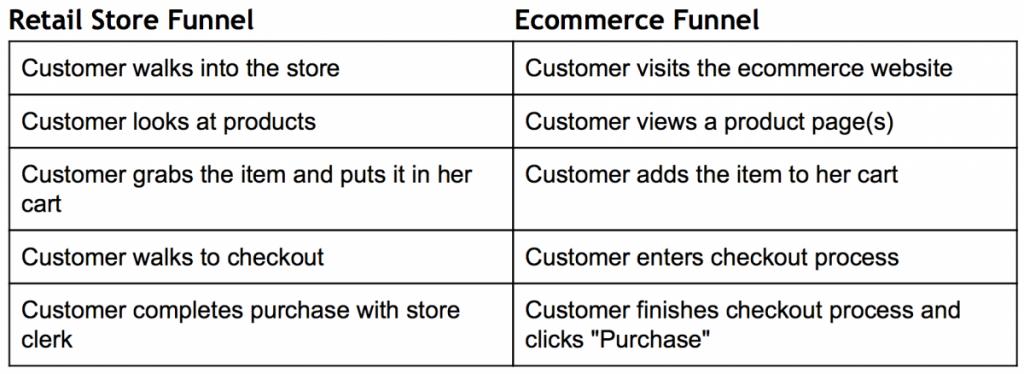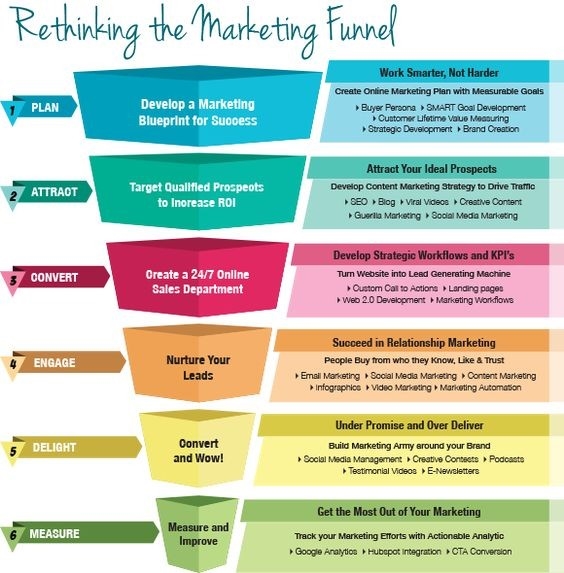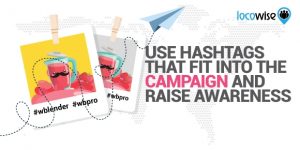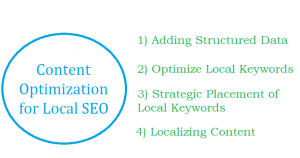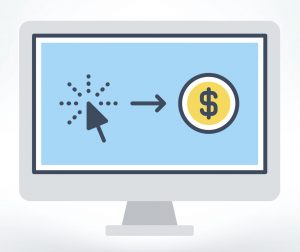— July 2, 2018
Most startups don’t fail because of bad ideas.
They fail because of bad assumptions, poor execution, and the failure to validate an idea or hypothesis early.
Despite, the fact that many articles have written about how to develop a Minimal Viable Product (MVP), you may be asking do we need ANOTHER post from someone else who has lived through a startup and may know something about startups?
I believe that answer is, YES.
MVP’s are one of the rare topics that enough can be written about.
The MVP thought process and mentality is one that I believe every entrepreneur should focus on mastering — and inherently it’s challenging to master simply because it’s human nature to complicate things.
Over the last year, I’ve had the privilege of talking with hundreds of entrepreneurs who have built many different types of new products.
Physical products, digital products, big products, small products, green products, products launched via Kickstarter and similar…
Founders in every vertical mentally create artificial barriers that prevent them from finding traction and real market validation. For many, this is not a conscious thought process or decision. It’s more driven by fear.
Fear of failure and rejection than anything else.
These obstacles are usually most profound in the early days of a startup simply because this is when available time and resources are the most limited. They are also almost always born out of an unnecessary assumption.
“I think that to do X to get to Y or for people to be interested in our product and company we must have X, Y, AND Z.
These are significant assumptions, with little to non-existent data to back them up.
The truth is that the hardest part of starting a business isn’t building something that people will buy — it’s winning this epic battle that we wage against ourselves.
Staying focused. Staying minimal.
Founders need to think and act like a cockroach: Instead of trying to solve all problems, you must focus your effort on solving the right problems for the right audience if you want your startup to live to see another day.
So how do you ensure that you are always focusing your time and energy on the right things and not getting trapped behind self-induced barriers?
This is where first time entrepreneurs and successful veterans typically diverge in their approach.
After hearing a pitch for a new product, I often ask “What’s preventing you from launching this tomorrow?”.
90% of the time there are one or two features that still need to be finished and “a few weeks away from launching.”
However “a few weeks away” turns into a month which turns into three months and so on.
The search for perfection kills many startups.
The danger in making too many assumptions is that your MVP quickly loses its minimalism and its viability. So you’re left with a product that was difficult to create or develop into what your customers want.
I think the root of the problem is less about assumptions and really because many people have a misconception of what an MVP is.
Which brings me back to the reason I’m writing yet ANOTHER post about minimal viable products.
Instead of thinking about an MVP as a first version of the final product, I like to think of an MVP as the experiment required to test and validate a hypothesis.
What’s surprising about this approach is you quickly realize that although it’s a bit of a misnomer, you may not even need a product to achieve this.
Your MVP can be as simple as an email list that results from spending $ 100 on Facebook ads to test your hypothesis.
So take a minute and ask yourself one simple question.
What’s preventing you from launching tomorrow? Probably less than you think.
My suggestion is that you bootstrap your business for as long as possible. Investors can add a layer of bureaucracy that you may not have the bandwidth to deal with. Also, not all investors have the best interest of the company at heart.
Some investors do not have the patience required for a startup and begin looking for an ROI long before the company is profitable and resort to disastrous methods attempting to force their will on founders.
Hypothesis tested, now what?

Now that you have tested your hypothesis and ideally have the beginnings of an email list it’s time to create your company.
I’m not going to spend any time on the legal requirements to form a business in this article; I want to focus on the actual mechanics required to bring a product to market.
You’ve validated your idea, show that there was a market demand, now you need to develop the actual product and go to market plan.
If you have a digital product offering, you need to write your or create your video series and build the platform that will hold the offering. This can be as simple as a WordPress website with a subscription plugin.
If it’s a hard good product, now is the time to locate a manufacturer. This can be done domestically or via websites such as Alibaba. You need to contact several manufacturers and ask for samples or have them take your design and fabricate samples. Quality matters, this product will carry your brand name.
Once you have market ready samples, it’s time to contact the people on your mailing list and ask for pre-orders. These pre-orders are when things get very real. Many people may say they are interested; now the rubber hits the road. The email sequence needs to raise awareness and create the marketing funnel.
Using a simple Google search, you can find many examples of email sequences that you can use as a model and customize for your product offering and re-engage your target list.
If you booked pre-orders, I would strongly suggest that you reconfirm the orders and then proceed with placing the first order from the manufacturer. No one wants to receive a product they forgot they ordered and you do not want excessive inventory that ties up cash.
Driving Web Traffic
Without traffic to your business or website you are a hobby at best and not a business.
Taking the ad that you ran on Facebook to test your hypothesis, you need to develop a complete marketing plan to attract an audience to your website, or if you are using Amazon for your platform, you need to drive traffic to your sales page.
What’s your brand story? Every brand needs a story, consumers want to know whom they are dealing with and the “why.”
Creativity and authenticity are important here; you need to define your target audience personas, the KPI’s and a content marketing strategy.
How will you build an emotional connection with your target market persons? People buy from brands they connect with, and many brands miss the mark or discount this aspect. Take the time and invest in developing your brand story and how you will connect with your consumer.
This effort will pay off handsomely.
What is social selling?
Next up is to develop a social selling plan. Social media needs to be a critical aspect of your marketing plan. Sales is about relationship building, establishing rapport and credibility, and providing the right solution to the right prospect at the right time.
Social selling doesn’t change that.
Social selling is the art of using social networks to find, connect with, understand, and nurture sales prospects. It’s the modern way to develop meaningful relationships with potential customers that keep you—and your brand—front of mind, so you’re the natural first point of contact when a prospect is ready to buy.
At its core, social selling is about finding and connecting with your target audience and prospects on social media to build relationships and increase sales.
B2B Companies Need to Incorporate Social Selling
We live in a digital world today. As a result, 74% of B2B buyers conduct more than half of their research online before contacting the business, and three out of four B2B buyers rely on social media to engage with potential companies before making a purchase decision. Social listening and sharing valuable content is no longer a nice-to-have, it’s a must have.
Step 1: How To Establish a Professional Brand
I strongly suggest that you begin with an audit of your social media channels. Most business professionals use Twitter and LinkedIn for business purposes, and consumers use Twitter, Facebook, Instagram and Snapchat, depending on your product offering.
You will need to decide which of these social media channels you should focus on and will bring the most success.
What should you consider when conducting an audit?
Presence: Set up your social media profiles with the customer in mind. Take a hard look at your profile and ask yourself: Is your brand you easy to find on social? Is your profile picture, profile description, company information, and handle consistently across all channels? Do you link out to your company’s website or to valuable content?
Personality: What you do on these social media channels is just one aspect of who you are. Don’t be afraid to show your personality (within reason, of course); people like to know whom they are dealing with.
Have a passion for football and music? Add it to your Twitter profile, what to give a shout out to your home state? Give it a shout-out and geotag your location.
The more information you share about yourself, the more likely you are to form a genuine connection with others who share similar interests. This allows you to start conversations with prospects who are not as likely to respond to posts about your product.
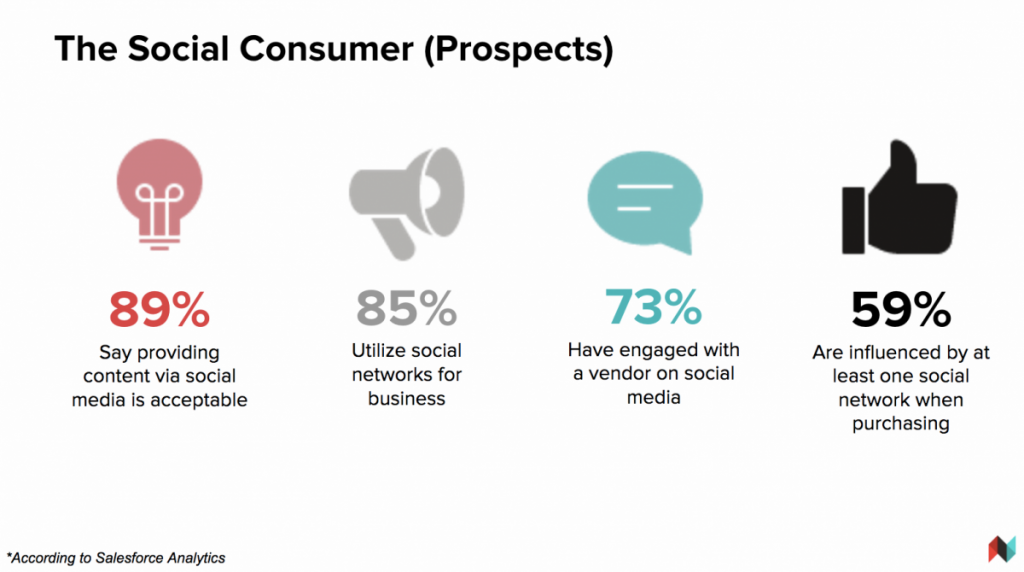 Step 2: Listen with Social Media
Step 2: Listen with Social Media
Now that you’ve optimized your social profiles, you need to start listening to conversations and connecting with your target personas. There are several tools that can facilitate social listening, however, before you choose one, you need to do some legwork first.
Follow + Connect: Invest time locating and following your target market personas and influencers on social media with every channel you are using. This allows you to develop a better sense of what they care about as buyers and who they are as people. Specifically, on LinkedIn, when sending out an request to join their network, you need to customize the request. If you don’t know the individual, giving a few details about why you want to connect with this person is more personable than having no context to the request.
Read + Analyze: In addition to following individual people, following key brands and subscribing to their emails and newsletters is critical. This gives you an overall sense of their personality or brand, if this is a B2B sales process, you will garner critical information on their current marketing efforts, and target audience. The more background information and insights you have, the better prepared you are.
Identify + React: Social Media gives you the ability to listen for buying signals from prospects. Is your prospect posting or asking for purchasing advice? Active social listening allows you the opportunity to jump into the conversation.
90% of all B2B buying decisions are influenced by peer recommendations, listening carefully to the conversations on social can identify when your target audience is ready to buy.
Once you have done the manual work in making connections and joining relevant groups, it’s time to choose a social listening tool.
Most of these tools offer free functionality; there’s no need to break the bank adding yet another tool to your marketing stack. I recommend to cover all of your social networks or Buffer for robust, customizable listening capabilities on Twitter.
Step 3: Engage on Social Media
The final step is perhaps the most critical in social selling: engaging with influencers industry leaders, and prospects on social. Not only will sharing content that you created to educate your audience or to share their content will help you connect with your target audience and grow your personal brand as well.
Share Content that Counts: Let’s be honest, there is a lot of horrible content on the web and in social media today.
You do not want to be adding to the noise. You want to be sharing, and retweet content that educates entertains and brings value to others. You want to be a problem solver.
Curating and sharing content other than just what your brand produces and publishes gives a sense of balance.
Being a resource gives you a softer sales approach and sharing third-party content is essential to building your brand and demonstrating an unbiased and honest point of view.
When someone publishes, or shares thought leadership content from you make sure to show your support and thank them. Thanking people for the consideration goes a long way towards building a long-term relationship.
Reach Out to Influencers:
One of the quickest ways to jump-start your brand is to reach out to influencers in your target market. Use the direct messaging function of most social media platforms and offer them your product for free. Yes, you heard me, free. No strings attached.
If they like the product, they should reciprocate with a shout out about the product. You now have the basis to develop a relationship with them. Make a list of influencers with 50,000 or fewer followers and start reaching out to them.
Plan Ahead: Today, with the tools mentioned above, it is easy to schedule a week’s worth of social media posts on just about every channel.
Engage with your Audience: The more interactive you are with your target audience, the better. Social media is being engaged and demonstrated by this by liking, sharing, retweet, and commenting on their posts.
Engaging with influencers, you position yourself as an expert in your field. This will help cultivate critical relationships with potential buyers.
This also allows you to develop and cultivate key relationships with your target audience. By starting a conversation on social media, you have an improved chance of moving to email with a significantly better chance than reaching out cold and blasting a brand message to an audience who has no relationship with you.
The ROI of Social Selling
There is a high potential for ROI with a minimum spend with social selling.
Social selling takes a mind shift and needs planning.
How to get started:
30 Minutes: At the start of the week, spend half an hour to schedule social media posts for Twitter, Facebook, Instagram and LinkedIn about your market area. This can be original ideas; custom created content that educates or entertains your target audience (content marketing) links to branded content or third-party content about what interests you the most.
20 Minutes: On Wednesday or Thursday invest 20 minutes for engagement and active listening. Participating and reading Facebook and LinkedIn group discussions, following hashtag conversations on Twitter, your follower’s pages, Instagram posts and jumping in where relevant. Sharing posts drives engagement with fans, thought leaders, and influencers.
10 Minutes: Every day, check all social channels you are using for notifications, friend requests, new followers and direct messages. When you start engaging and contributing more, you’ll notice an influx of inbound requests.
Content Marketing
“Content marketing is a strategic marketing approach focused on creating and distributing valuable, relevant, and consistent content to attract and retain a clearly defined audience — and, ultimately, to drive profitable customer action.”
Content Marketing is providing truly relevant and useful content to your target audience to help them solve their problems verse pitching your products or services.
Content that is not relevant and valuable is informational garbage. The web and social media is full of companies trying to sell you “stuff,” it’s most of the time it’s not relevant or valuable.
It’s spam.
No marketing is possible without great content
Content marketing should be part of your marketing tactics, not a separate part.
Marketing regardless of the tactics used depends on quality content:
- Social media marketing: No social media strategy can or will be successful without a content marketing strategy.
- SEO: Google and other search engines reward businesses that publish quality, relevant content consistently.
- PR: Successful PR strategies address issues readers care about, not your business.
- PPC: For PPC to work, you need great content behind it.
- Inbound marketing: Driving inbound traffic and leads requires content marketing.
- Content strategy: Content strategy is part of most content marketing strategies.
That’s what makes content marketing so important in today’s environment of consumers being bombarded with thousands of marketing messages each and every day.
Email Marketing
With very limited marketing dollars in your budget, you want to make sure you’re spending your money and time effectively.
Email makes money. For every $ 1 you spend on email marketing, you can expect an average return of $ 38.
Social selling combined with content marketing can and will drive email marketing. Every piece of content created needs to have a call to action coupled with a lead generation offer that drives email capture. There are several great examples of email campaigns that you can review and customize for your product offering.
Best practices for email marketing subject line is as follows:
When it comes to subject lines, boring works best. When you write your subject line, don’t sell what’s inside—tell what’s inside.
How effective is email marketing, the stats tell all…..
Wrapping it Up:
Bootstrapping a business is not that difficult, it takes forethought and planning.
The tools outlined here are all relatively inexpensive, it takes effort and some hard work coupled with dedication. As your business grows, then look into adding in social media marketing (SMM) and pay per click (PPC) ads.
Your biggest opportunities are in growing your audience, by using content marketing coupled with social selling to educate and/or entertain your target audience.
This drives web traffic and turns your website into a lead generation machine.
Using lead generation tools you can easily build an email list of prospects that are interested in your content and products.
People are looking to have their problems solved; that is where your products come in.
Building relationships and trust drive sales. People buy from whom they trust
Always under promise and over deliver.
Lastly, take care of the customer, and they will take care of you.
Business & Finance Articles on Business 2 Community
(149)
Report Post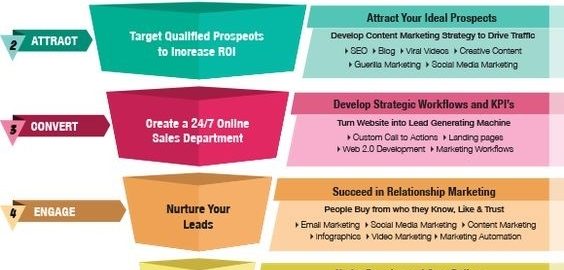
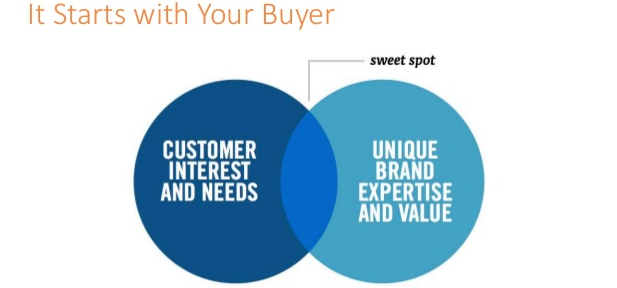
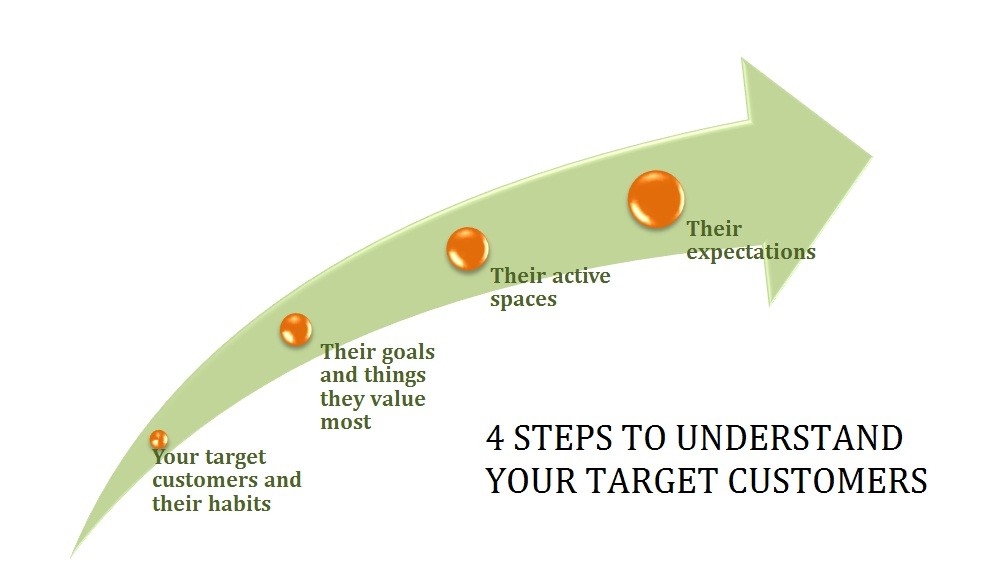 Every business depends on traffic to drive sales and revenue.
Every business depends on traffic to drive sales and revenue.